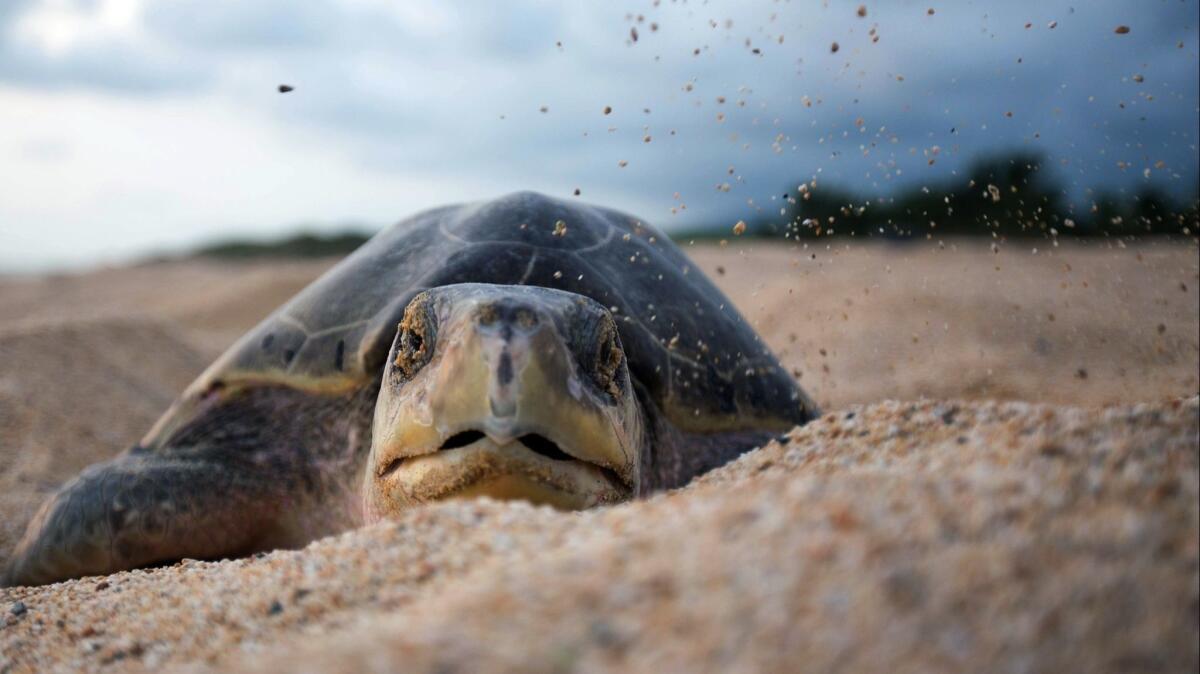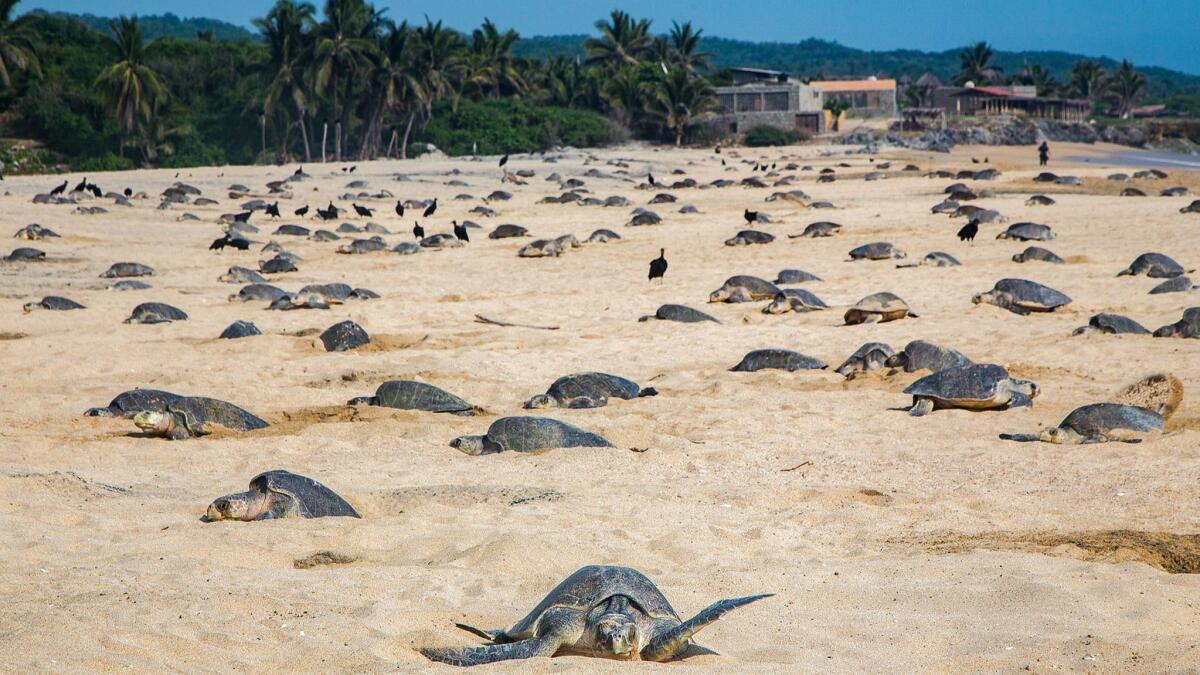Return of the olive ridley: Sea turtles make spectacular comeback in Mexico
- Share via
Reporting from Playa Morro Ayuta, Mexico — They appear as ghostly shadows riding beneath the surf, their beaks and shells illuminated in the moonlight as they drift in the swells.
As dawn approaches, columns of the primordial figures emerge clumsily from the sea, and by mid-morning, the lumbering, 80-pound-plus amphibious invaders will have overtaken the beach, their flippers kicking up tufts of sand and the pounding of their shells against the wet sand complementing the crashing waves.
Welcome to one of nature’s most cinematic scenes — the synchronized mass-nesting, or arribada (arrival), of female olive ridley sea turtles along Mexico’s Pacific coast.
Hundreds of thousands of golfinas, as they are known here, may hit the beach during arribadas, occurring roughly once a month between July and February.
Still officially listed as endangered, the olive ridley has nonetheless made a spectacular recovery. Conservationists credit both legal protections and a generational shift in attitude among Mexicans who once sustained the industrial-scale looting of eggs, which were eaten and regarded as a male aphrodisiac.
“We can see that this species of turtle is on the road to recuperation,” said Angel Guillermo Gonzalez Padilla, coordinator of the Mexican environmental agency’s protection efforts here, as he observed thousands of nesting olive ridleys on a stretch of this white-sand beach.
While the species still faces threats such as floating fishing tackle, climate change, beach erosion, plastic and other sources of pollution, biologists say the upswing in nests here is a clear sign that the reptile’s numbers may be stabilizing, if not increasing.

Some little-understood primal imprint—possibly related to the Earth’s magnetic field, wave patterns, currents and singular smells—drives egg-bearing females to return from prolonged marine wanderings to the beaches where they were born years earlier. They deposit individual clutches of about 100 eggs. Mass nestings also take place on beaches in Costa Rica and India.
A record 4.6 million olive ridleys nested last year on Mexico’s Pacific coast, mostly here at Playa Morro Ayuta in Oaxaca state and up the coast at Playa Escobilla.
It’s a stunning turnaround from the 1980s, an era of vast egg poaching and commercial turtle slaughter in Mexico when the annual arrival of the turtles averaged about 120,000.
In 1990, a presidential decree outlawed the capture of sea turtles and banned collecting their eggs in Mexico, where beaches provide nesting sites for six of the world’s seven sea turtle species. Mexican troops and environmental teams now patrol nesting beaches to deter hueveros, the illicit egg gatherers.
While other sea turtles such as the endangered Kemp’s ridley have also staged comebacks in Mexico, the scope of the olive ridley nesting assemblages is unmatched. Scientists view the phenomenon as an evolutionary adaptation — known as “predator swamping” — in which there is simply more prey than predators.
Last year, authorities say, 77 million olive ridley hatchlings made their way toward the sea on Mexican beaches, though only 1 in 1,000 are said to actually reach adulthood.
While human poaching remains a problem, it is now regarded here as less of a peril to the turtles than other dangers, such as the “ghost nets,” the abandoned fishing tackle floating in the sea that can entangle the turtles.
In late August, more than 300 olive ridleys, apparently females poised to nest, were snared in nets floating off the coast of Oaxaca. All drowned. Images of the trapped, helpless turtles drew global alarm.
Though now considered the most abundant sea turtle, the olive ridley — 2 to 2½ feet long and weighing 80 to 110 pounds -- is still listed as “in threat of extinction” in Mexico.
“Yes we have succeeded in increasing the number of nesting turtles, but that is not to say that this species is out of danger,” said Valeria Towns, who oversees threatened species for Mexico’s National Protected Areas Commission.
Added Christine Figgener, a marine biologist at Texas A&M University: “We need a lot more answers to questions about how many olive ridleys are out there and what threats they are facing.”

The olive ridley inhabits tropical and warm waters of the Pacific, Atlantic and Indian oceans, feeding on crustaceans, jellyfish and mollusks. Its name derives from the pale green hue of its roughly heart-shaped top shell, though the etymology of “ridley” remains unclear.
Less than a generation ago, the olive ridley in Mexico seemed to be hurtling on a headlong path toward doom.
Divers caught multitudes at sea each year during the 1980s and earlier to be harvested for meat, skin and shells, and coastal slaughterhouses served as a grisly final stop for the peripatetic turtles.
Grainy footage from the era recently aired on Mexico’s Televisa network showed a grotesque scene with a row of captive olive ridleys arrayed on a table where a worker would fire a pistol into the animals’ heads. Another clip displayed a pile of butchered turtles, some with their limbs still flapping spasmodically.
“The blood ran into the ocean,” recalled Miguel Garcia Lopez, 70, who worked in a turtle slaughterhouse at San Agustinillo, a beachside hamlet up the coast from here. “It was quite horrible, yes. But the factory provided work.”
Now, San Agustinillo and neighboring Mazunte are thriving beach resorts lacking any trace of the old turtle killing grounds.
During the turtle-harvesting days, armies of locals on foot and horseback regularly descended on nesting beaches.
“It was like a party,” recalled Arsenio Rey, 65, a lifelong resident of the nearby coastal village of Tapanala. “People on the beach would sell coffee, tamales, the whole town went to gather eggs.”
Poachers on horseback still prowl the nesting zones, digging into the sand and filling sacks with hundreds of eggs. But their numbers are greatly reduced.
Throughout the coastal area, a concerted public awareness effort has sought to refute the deep-rooted notion that consuming turtle eggs enhances male virility. Hatchling releases —in which children get to place newborns on beaches-- have become popular and appear to have reinforced the idea that sea turtles are a resource to be preserved, not consumed.

“We have seen a big change in attitude, especially with the young,” noted Luis Angel Rojas, who coordinates marine turtle protection efforts here for Wildcoast, a California-based conservation nonprofit. “Children are now telling their fathers and grandfathers: ‘Please, don’t eat turtle eggs.’”
On a recent morning, the arribada commences before dawn under the glow of a full moon. Soon the beach is teeming with turtles, their tracks crisscrossing the sand like tank tread markings.
Ping-pong-ball-sized eggs litter the area. In their exertions, the mothers regularly dig up incubating eggs left by previous waves of olive ridleys.
Dogs stalk the beach seeking turtle-egg snacks. Vultures and predatory birds hover.
The turtles advance beyond the high-tide line, find an appropriate spot and begin excavation with both sets of flippers, seemingly oblivious to the presence of others, sometimes in shell-to-shell proximity on the beach. They pound down with their shells to create oval-shaped body pits. Hind flippers spade out cavities for the eggs.
The creatures go into a kind of trance as they release their eggs then use their hind flippers to cover them with sand, hiding them from predators and ensuring the eggs remain moist and maintain proper incubation temperature.
The nesting turtles generally spend an hour or so on land.
There is no mother’s care for the hatchlings, which will emerge as dark-toned diminutives in about 50 days, facing astronomical odds against survival.
Done with their maternal duties, the wearied olive ridleys often pause at the shoreline, content to let the tide carry them back to sea, where they are graceful swimmers, not plodding terrestrial beasts driven by instinct to fulfill their evolutionary burden.
Special correspondents Liliana Nieto del Rio and Cecilia Sanchez of the Times’ Mexico City bureau contributed to this article.
Twitter: @PmcdonnellLAT
More to Read
Sign up for Essential California
The most important California stories and recommendations in your inbox every morning.
You may occasionally receive promotional content from the Los Angeles Times.













